The Drosophila Bottles Market is estimated to be valued at USD 62.0 million in 2025 and is projected to reach USD 108.0 million by 2035, registering a compound annual growth rate (CAGR) of 5.7% over the forecast period.
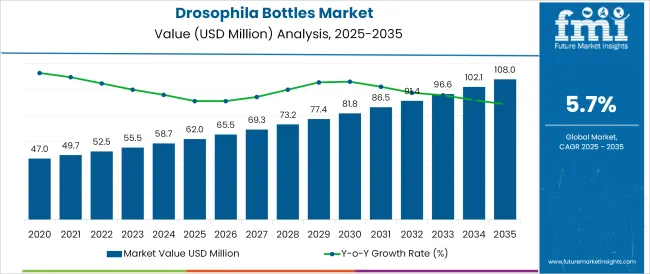
The Drosophila bottles market is advancing steadily, supported by rising demand from genetic and developmental biology research. The increasing focus on molecular and behavioral studies has driven higher consumption of controlled rearing solutions, with Drosophila bottles serving as an essential component for maintaining experimental integrity.
The shift toward standardized, contamination-resistant, and reproducible research materials has encouraged wider adoption of specialized bottles, particularly in academic and commercial laboratories. Future growth is anticipated to be shaped by advances in material sciences, greater emphasis on laboratory efficiency, and expanding research funding.
Operational needs for sterility, ease of handling, and scalability are paving the way for continued innovation in design and material use, strengthening the market’s outlook in both established and emerging research hubs.
The market is segmented by Material, Capacity, and End Use and region. By Material, the market is divided into Plastic and Glass. In terms of Capacity, the market is classified into 100-250 ml, Below 100 ml, 250-500 ml, 500-1000 ml, and 1000 ml and Above. Based on End Use, the market is segmented into Research Laboratories, Educational Institutions, and Pharmaceutical Companies. Regionally, the market is classified into North America, Latin America, Western Europe, Eastern Europe, Balkan & Baltic Countries, Russia & Belarus, Central Asia, East Asia, South Asia & Pacific, and the Middle East & Africa.
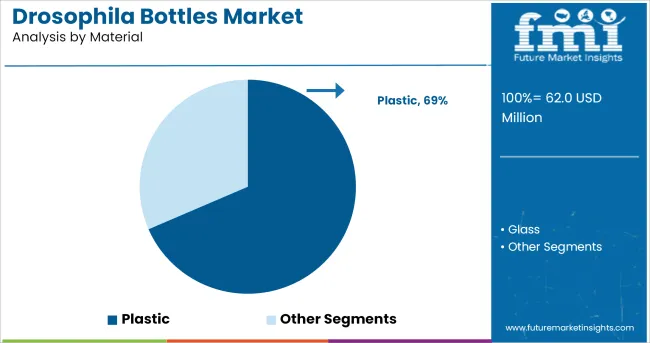
When segmented by material, plastic is expected to account for 68.5% of the total market revenue in 2025, securing its position as the dominant material segment. This leadership is attributed to the material’s light weight, durability, and ability to maintain sterile conditions, which have proven essential in laboratory environments.
Plastic bottles have also been preferred due to their cost efficiency, consistent quality, and compatibility with automation systems. Enhanced resistance to breakage and ease of disposal have further contributed to their widespread acceptance.
The ability to manufacture bottles in high volumes while maintaining precision and reliability has reinforced plastic’s predominance in meeting the rigorous demands of research laboratories.

In terms of capacity, bottles within the 100-250 ml range are projected to hold 34.0% of the market revenue in 2025, emerging as the leading capacity segment. This preference has been driven by their suitability for most experimental protocols, offering an optimal balance between space efficiency and adequate volume for sustaining Drosophila cultures.
Their versatility across various experimental setups, coupled with ease of handling and storage, has enhanced their appeal. Laboratories have favored this size for its ability to support standardized experimental conditions while minimizing waste and operational costs.
The compatibility of this capacity with commonly used racks and incubation chambers has further supported its leadership in the market.
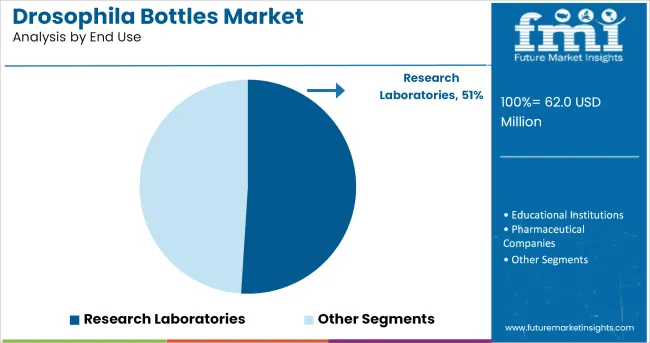
When segmented by end use, research laboratories are forecast to contribute 51.0% of the market revenue in 2025, retaining their position as the foremost end-use segment. This prominence has been reinforced by the growing scale and complexity of biological research requiring controlled environments for Drosophila maintenance.
Laboratories have increasingly relied on high quality, consistent, and easy to use bottles to ensure experimental reproducibility and minimize contamination risks. The increasing number of genetic research projects, coupled with enhanced funding for life sciences, has amplified demand from academic, government, and private research facilities.
The ability of laboratories to adopt standardized practices and their need for reliable consumables have cemented their role as the primary consumer segment in this market.
Genetic market is growing every year and future of healthcare industry is in the gene-therapy, the biotech companies are focusing on increasing the product range in gene therapy market and they are trying hard by raising funds for research and development in genetic studies which increases the consumption of drosophila bottles in the market and hence drives the demand globally.
The increasing healthcare expenditure and government raising funds for research and development in their particular region helps in boosting the market growth globally.
Drosophila melanogaster is the widely used fly for the genetic sequence study and scientist needs the bottles for culturing the media for the flies hence boosts the market demand.
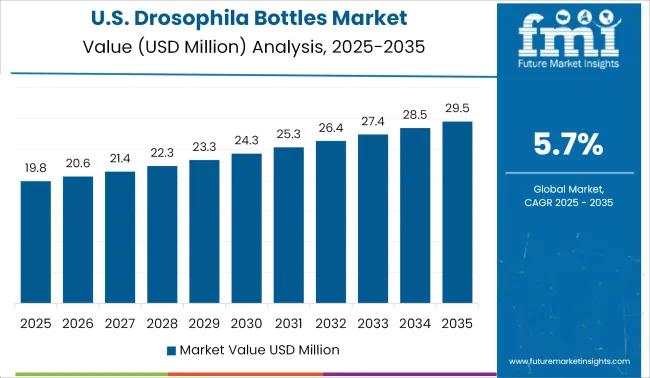
USA and Canada are the leading region in relevance to research and development, the expenditure on the healthcare sector is highest in the region as compared globally, hence this defines the top position of USA and Canada in the drosophila bottles market. The presence of technically advanced laboratories for research, raising funds in R&D sector, boosts the growth of the market in the region.
Most of biotech companies are established in North American region hence the R&D sector is vast in the region which is focusing on the Bio-genetic therapies which hikes the growth of the market.
Considering the healthcare sector Europe is at the second position in market.
The research and development sector are much advanced and is enough able to crack down the developments hard and fast, hence the consumption of drosophila bottle is increasing every year which drives the growth of the market. The fund raising in R&D sector by the government drives the market growth in the region
Asia pacific is the fastest developing region in the world hence forth the market will grow thrivingly in the region, India and China are two main developing hubs of Asia pacific, Due to presence of raw material, wide forest land and large number of skilled labours the region is on the way to fly high and will definitely attain to its aim in forecast period.
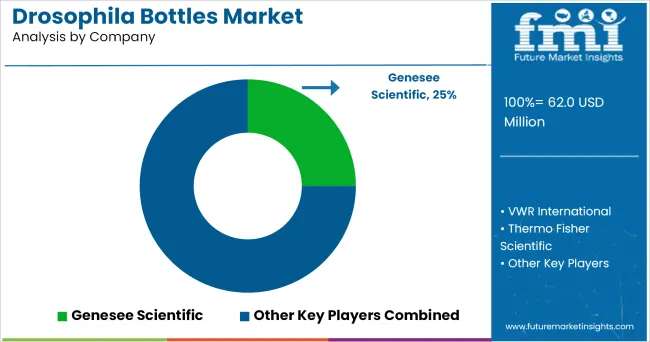
According to FMI analysis
are identified as the key players of the Drosophila Bottles Market.
ELSE-nnovation Life Science provides high quality of drosophila bottles with premium quality of Polystyrene, k-resins, and polypropylene.
The report is a compilation of first-hand information, qualitative and quantitative assessment by industry analysts, inputs from industry experts and industry participants across the value chain.
The report provides in-depth analysis of parent market trends, macro-economic indicators and governing factors along with market attractiveness as per segments. The report also maps the qualitative impact of various market factors on market segments and geographies.
The global drosophila bottles market is estimated to be valued at USD 62.0 million in 2025.
The market size for the drosophila bottles market is projected to reach USD 108.0 million by 2035.
The drosophila bottles market is expected to grow at a 5.7% CAGR between 2025 and 2035.
The key product types in drosophila bottles market are plastic and glass.
In terms of capacity, 100-250 ml segment to command 34.0% share in the drosophila bottles market in 2025.






Our Research Products

The "Full Research Suite" delivers actionable market intel, deep dives on markets or technologies, so clients act faster, cut risk, and unlock growth.

The Leaderboard benchmarks and ranks top vendors, classifying them as Established Leaders, Leading Challengers, or Disruptors & Challengers.

Locates where complements amplify value and substitutes erode it, forecasting net impact by horizon

We deliver granular, decision-grade intel: market sizing, 5-year forecasts, pricing, adoption, usage, revenue, and operational KPIs—plus competitor tracking, regulation, and value chains—across 60 countries broadly.

Spot the shifts before they hit your P&L. We track inflection points, adoption curves, pricing moves, and ecosystem plays to show where demand is heading, why it is changing, and what to do next across high-growth markets and disruptive tech

Real-time reads of user behavior. We track shifting priorities, perceptions of today’s and next-gen services, and provider experience, then pace how fast tech moves from trial to adoption, blending buyer, consumer, and channel inputs with social signals (#WhySwitch, #UX).

Partner with our analyst team to build a custom report designed around your business priorities. From analysing market trends to assessing competitors or crafting bespoke datasets, we tailor insights to your needs.
Supplier Intelligence
Discovery & Profiling
Capacity & Footprint
Performance & Risk
Compliance & Governance
Commercial Readiness
Who Supplies Whom
Scorecards & Shortlists
Playbooks & Docs
Category Intelligence
Definition & Scope
Demand & Use Cases
Cost Drivers
Market Structure
Supply Chain Map
Trade & Policy
Operating Norms
Deliverables
Buyer Intelligence
Account Basics
Spend & Scope
Procurement Model
Vendor Requirements
Terms & Policies
Entry Strategy
Pain Points & Triggers
Outputs
Pricing Analysis
Benchmarks
Trends
Should-Cost
Indexation
Landed Cost
Commercial Terms
Deliverables
Brand Analysis
Positioning & Value Prop
Share & Presence
Customer Evidence
Go-to-Market
Digital & Reputation
Compliance & Trust
KPIs & Gaps
Outputs
Full Research Suite comprises of:
Market outlook & trends analysis
Interviews & case studies
Strategic recommendations
Vendor profiles & capabilities analysis
5-year forecasts
8 regions and 60+ country-level data splits
Market segment data splits
12 months of continuous data updates
DELIVERED AS:
PDF EXCEL ONLINE
Bottles Market Analysis - Growth & Forecast 2025 to 2035
PET Bottles Market Demand and Insights 2025 to 2035
PCR Bottles Market Growth - Demand, Innovations & Outlook 2024 to 2034
Beer Bottles Market Size and Share Forecast Outlook 2025 to 2035
Market Share Insights for Beer Bottles Providers
MDPE Bottles Market
Glass Bottles Market Forecast and Outlook 2025 to 2035
Smart Bottles Market Size and Share Forecast Outlook 2025 to 2035
Glass Bottles And Containers Market Size and Share Forecast Outlook 2025 to 2035
Serum Bottles Market Size and Share Forecast Outlook 2025 to 2035
Paper Bottles Market Growth - Demand & Forecast 2025 to 2035
Competitive Overview of Glass Bottles Market Share
Market Positioning & Share in the Serum Bottles Market
Dosing Bottles Market Size and Share Forecast Outlook 2025 to 2035
Coffee Bottles Market Insights & Industry Trends 2025 to 2035
Bullet Bottles Market Growth – Demand & Forecast 2025 to 2035
Competitive Overview of Dosing Bottles Providers
Tubes, Bottles and Tottles Market
Plastic Bottles Market Size and Share Forecast Outlook 2025 to 2035
Beveled Bottles Market Growth – Demand & Forecast 2025 to 2035

Thank you!
You will receive an email from our Business Development Manager. Please be sure to check your SPAM/JUNK folder too.
Chat With
MaRIA